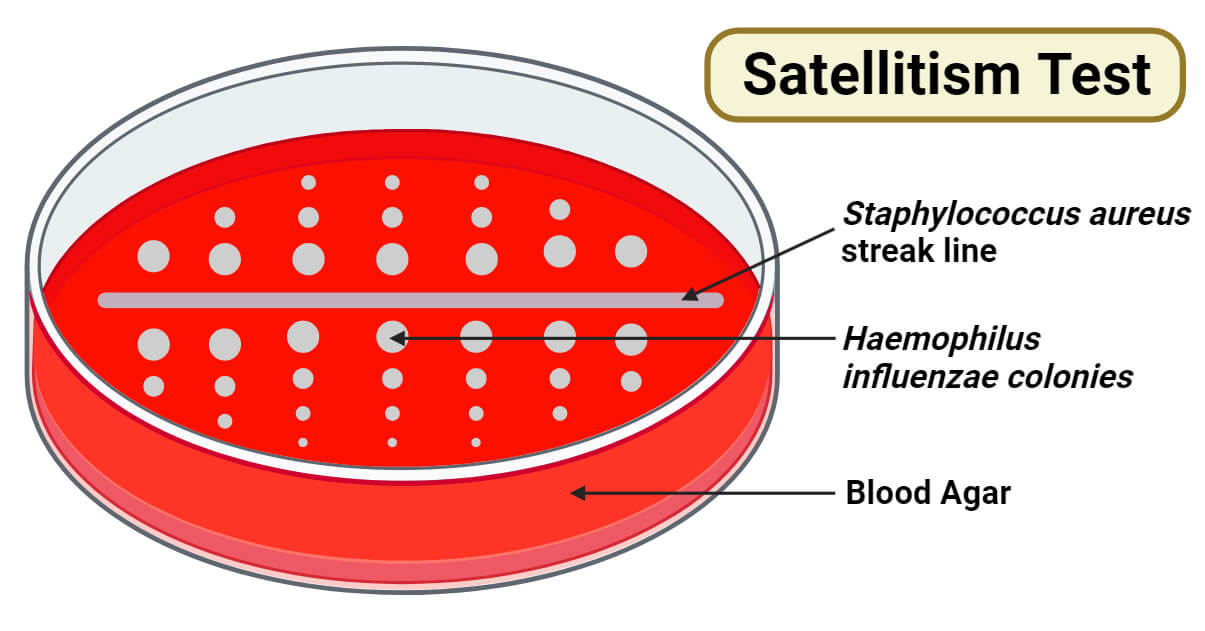Haemophilus spp. requires either or both of the X-factor (hemin or protoporphyrin IX) and V-factor (nicotinamide adenine dinucleotide (NAD)) for their growth and survival. Haemophilus spp. can be distinguished down to the level of the species based on whether they require either one or both of these growth factors.
The Satellitism test is one of the biochemical tests used to distinguish Haemophilus influenzae from other Haemophilus spp. based on the differential requirement of the X-factor and the V-factor.
H. influenzae require both X and V-factors for their growth whereas most of the other common pathogenic Haemophilus spp. require only one of the two growth factors.
Interesting Science Videos
Objectives of Satellitism Test
- To identify Haemophilus influenzae.
Principle of Satellitism Test
Blood agar medium provides only an X-factor, but for obtaining a V-factor, the erythrocytes present in the blood agar must be haemolyzed. H. influenzae can neither haemolyze the blood nor grow without the V-factor, so H. influenzae alone can’t grow in a blood agar medium.
Staphylococcus aureus is hemolytic, and its presence in the blood agar medium makes V-factor (NAD) available in the medium. Hence, H. influenzae can grow in the vicinity of S. aureus colonies in the blood agar medium. This phenomenon is called ‘satelliting’.
Requirements for Satellitism Test
1. Culture Media
A Blood Agar Medium is used for performing this test.
Composition of Blood Agar Base per 1000 mL
Beef Heart Peptone – 10.0 grams (Alternatively, Meat Extracts – 10.0 grams)
Peptone – 10.0 grams (Alternatively Tryptose – 10.0 grams)
Sodium Chloride – 5.0 grams
Agar – 15.0 grams
Final pH – 7.3 ±0.2 at 25°C
(References: https://www.sigmaaldrich.com/deepweb/assets/sigmaaldrich/product/documents/107/012/70133dat.pdf
https://www.himedialabs.com/us/m073-blood-agar-base-infusion-agar.html)
Preparation of Blood Agar Plate
- Measure the appropriate amount of Blood Agar Base powder (40 grams for the above composition) and mix in the water of the required volume in a conical flask or glass bottle according to the instruction of the manufacturing company.
- Stir well using a magnetic stirrer or manually and heat to boiling so that all the components and agar dissolve completely in water.
- Autoclave the flask or bottle at 121°C and 15 lbs pressure for 15 minutes and let it cool to around 40 – 45°C.
- Pour 5% (5 to 10%) v/v sterile defibrinated Sheep Blood into the flask with blood agar base slowly with constant stirring. Mix properly so that blood dissolves uniformly in the medium. This mixture is the Blood Agar.
- In a sterile Petri plate (glass plate with 10 cm diameter), pour around 25 mL of the blood agar and let it solidify properly by leaving it at room temperature.
2. Reagents
No reagents are required.
3. Equipment
| Petri Plates | Micropipette | Cotton Swab/Inoculating Loop |
4. Test Organisms
- Sample Bacteria (Haemophilus spp.)
- Staphylococcus aureus ATCC 25923
5. Control Organisms
- Haemophilus influenzae ATCC 35056
- Haemophilus haemolyticus ATCC 33390
Procedure of Satellitism Test
- Prepare a suspension of identified Haemophilus spp. colonies (or suspected Haemophilus influenzae).
- Prepare a suspension of S. aureus.
- Using a sterile inoculating loop, streak the suspension in a blood agar medium plate. (Streaking in lines in one direction along the plate will be easy to read.)
- Using another sterile loop, pick a loopful S. aureus suspension and streak in a line across the inoculated/streaked Haemophilus spp. (Perpendicularly intersecting the lines of inoculation of Haemophilus spp.)
- Incubate the plate at 35±2°C for about 24 hours at 5% CO2.
Result and Interpretation of Satellitism Test
- The growth of small colonies only in the close vicinity of the S. aureus colonies indicates H. influenzae.
- H. haemolyticus and H. parahaemolyticus are hemolytic in nature; hence, can grow without S. aureus.
- Growth of bacteria across the plate – near and away from S. aureus colonies – indicates Haemophilus spp. that they either need X-factor only or are hemolytic.

Precautions
- Make sure the blood agar plate is sterile and not haemolyzed before inoculation.
- While transferring Haemophilus colonies for making suspension, make sure no piece of chocolate agar medium is transferred.
- Incubate in the presence of 5% CO2.
Applications of Satellitism Test
- To identify isolated Haemophilus spp. as Haemophilus influenzae.
- To differentiate Brucella spp. from Haemophilus spp.
Limitations of Satellitism Test
- It is unable to separate H. influenzae and H. aegyptius.
- H. ducreyi don’t grow in Blood agar even in the presence of S. aureus.
- The bacteria first need to be identified as a member of Haemophilus spp. using Gram staining or other biochemical tests.
- Nutritionally variant Streptococci (NVS) like Abiotrophia defectiva and Granulicatella species, Neisseria spp., and diphtheroid also give a positive result for this test.
References
- Leber, Amy L., editor in chief. (2016). Clinical microbiology procedures handbook (Fourth edition) . Washington, DC : ASM Press 1752 N St., N.W., [2016] doi:10.1128/9781555818814.ch3.17.33
- Cowan & Steel’s Manual for identification of Medical Bacteria. Editors: G.I. Barron & R.K. Felthani, 3rd ed 1993, Publisher Cambridge University Press.
- Bailey & Scott’s Diagnostic Microbiology. Editors: Bettey A. Forbes, Daniel F. Sahm & Alice S. Weissfeld, 12th ed 2007, Publisher Elsevier.
- Xi Y, Wang H, Wang S, Wu X, Wang Z. A study of various factors affecting satellitism tests of Haemophilus influenzae and Haemophilus parainfluenzae using Staphylococcus aureus as the source of NAD. J Microbiol Methods. 2022 Feb;193:106417. doi: 10.1016/j.mimet.2022.106417. Epub 2022 Jan 13. PMID: 35033634.
- Evans NM, Bell SM, Smith DD. New satellitism test for isolation and identification of Haemophilus influenzae and Haemophilus parainfluenzae in sputum. J Clin Microbiol. 1975 Jan;1(1):89-95. doi: 10.1128/jcm.1.1.89-95.1975. PMID: 170304; PMCID: PMC274947.
- Satellitism Test for Haemophilus influenzae • Microbe Online
- SATELLITISM TEST – Everything Microbiology (microbiologyclass.net)
- Satellitism Test for the Identification of Haemophilus influenzae (medicallabnotes.com)
- Satellitism test for the identification of Haemophilus influenzae: Introduction (universe84a.com)
- Satellitism test_Haemophilus influenzae (microbe-canvas.com)
